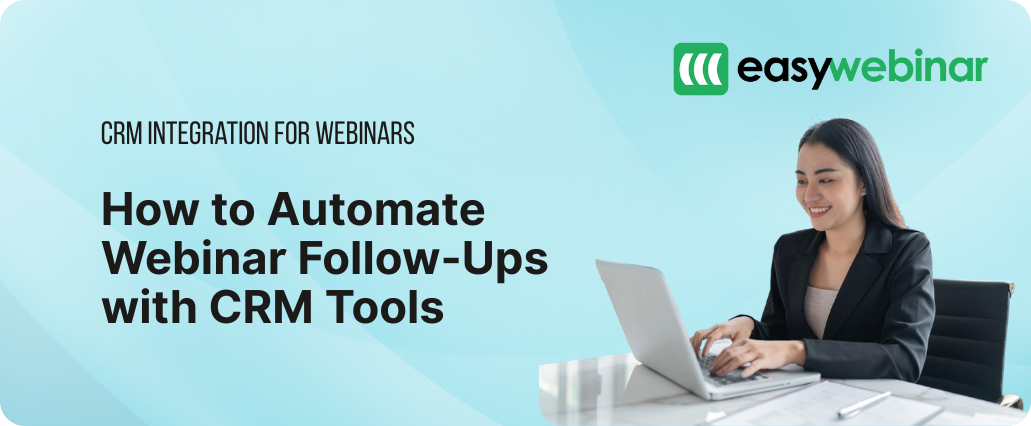CRM Integration for Webinars: How to Automate Webinar Follow-Ups with CRM Tools

Summary :
CRM integration transforms how marketers handle webinar follow-ups by automating communication, data transfer, and audience segmentation. This blog explores how combining webinar platforms with CRM systems helps marketers save time, personalize outreach, and boost conversions. You’ll learn how to set up CRM integration, map data fields, trigger automation, and use tools like EasyWebinar for seamless lead nurturing. With real-time engagement tracking, automatic segmentation, and Power Follow-Ups, you can deliver timely and targeted messages to every registrant, all while maintaining data compliance and maximizing ROI.
Table of Contents
- Understanding CRM Integration for Webinars
- Setting Up CRM Integration with Webinar Tools
- Automating Webinar Follow-Ups with CRM Tools
- Use Cases and Best Practices for CRM Integration
- Conclusion
- FAQs
Studies show that webinars contribute to as much as 60% of new business pipeline in B2B marketing.
Webinars are powerful lead generation machines that work best when you nurture those connections afterward. Manual follow-ups with each attendee become overwhelming, especially as your webinar program grows.
Webinar automation changes your approach completely. Your webinar platform and CRM system integration helps you simplify processes like registration, follow-ups, and data synchronization. This saves you valuable time and increases efficiency.
The benefits of webinar automation go beyond just convenience. Companies can earn 40% more revenue through CRM integration and personalization. This makes it a vital strategy to maximize your webinar ROI. Modern webinar automation tools connect to over 5,000 apps. You can create smooth processes without writing any code.
In this piece, we’ll show you how to sync your webinar data with CRM systems. You’ll learn to set up automated follow-up sequences and make use of the right webinar marketing automation strategies that convert more attendees into customers.
Understanding CRM Integration for Webinars
CRM integration plays a vital role as the foundation of successful webinar marketing strategies. You can make use of powerful automation capabilities that revolutionize your webinar follow-up process by learning how these systems work together.
What is CRM integration?
CRM integration connects your Customer Relationship Management system with other business applications, specifically your webinar platform. This connection enables smooth data flow between systems and eliminates data silos that usually exist between marketing tools. The integration creates an automatic, two-way connection that keeps both systems in sync, replacing the need to manually export and import CSV files after each webinar.
This integration acts as a two-way street for information exchange. Your webinar platform sends attendee information, questions, poll responses, and engagement metrics to your CRM automatically. Your CRM then pushes registration data to your webinar platform.
How CRM and webinar platforms work together
Through collaboration with CRM systems and webinar platforms, a unified ecosystem manages attendee relationships effectively. These properly configured integrations allow you to:
- Register clients automatically for webinars when they submit contact details on your website
- Make registration processes smoother through two-way data synchronization
- Track webinar analytics including attendance, engagement levels, and poll responses
- Update CRM databases automatically
The integrations also sync activity data between platforms to track registrations, attendance, and content engagement. This detailed data collection creates what many marketers call “a single source of truth” for all webinar-related customer interactions.
Benefits of webinar automation for marketers
Webinar automation through CRM integration offers benefits way beyond the reach and influence of convenience. Companies can boost their revenue by 40% through personalization using these integrated systems.
Marketers also gain these critical capabilities:
- Complete customer insights: Access detailed attendee information including purchase history and their path to your webinar
- Custom communication: Create personalized follow-ups based on specific attendee behaviors
- Better campaign results: Build targeted campaigns through behavior-based segmentation
- Detailed analytics: Create comprehensive reports on repeat registrants, engagement levels, and geographical distribution
These integrated systems change how businesses leverage webinar data, which optimizes touchpoints throughout the customer’s experience and creates more efficient lead management processes.

Setting Up CRM Integration with Webinar Tools
CRM integration setup needs careful planning to create smooth data flow between your webinar platform and CRM system. The right approach will help you build an automation system that captures attendee data and improves follow-up campaigns.
Choose a compatible webinar platform like EasyWebinar
Your first step is to pick a webinar platform with reliable integration features. EasyWebinar offers extensive integration options and connects naturally with popular CRM and email marketing systems like HubSpot, GetResponse, ActiveCampaign, and others. Your preferred CRM might not have direct support, but EasyWebinar works with Zapier to integrate with over 1,500 applications. This gives flexibility to almost any business setup.
Connect your CRM using native or third-party tools
The platform selection leads you to the “Integrations” section within EasyWebinar. You can pick your CRM from available options and verify the connection. Native integrations usually need your login credentials or API keys. Third-party connectors like Zapier can help bridge systems that lack direct integration, which allows effective communication between your systems.
Map data fields for registration and engagement
Good data field mapping transfers the right information between systems. The important fields to map include:
- Contact information: Name, email, company name
- Webinar details: Registration status, attendance status
- Engagement metrics: Poll responses, questions asked, time viewed
EasyWebinar lets you create custom tags for specific actions like “Registered,” “Attended,” “Missed,” “Watched Replay.” These tags help segment your audience for targeted follow-ups.
Test and validate the integration
A test webinar with several test participants will help verify correct data flow between systems. The testing process should:
- Check registration data sync to your CRM
- Confirm accurate capture of engagement metrics
- Test automation trigger functionality
- Look for data mapping issues
This full testing gives you a clear picture of your webinar automation tools’ performance. It prevents data loss and automation failures during live webinars.
Automating Webinar Follow-Ups with CRM Tools
Your CRM integration starts working its magic through automated follow-up processes after setup. Webinar automation revolutionizes manual outreach into smart, timely communications that boost conversions.
Send customized emails to attendees and no-shows
Generic “thank you for attending” emails no longer work effectively. Subject line personalization boosts open rates by 26%. CRM integration automatically segments your audience based on their webinar behavior and creates tailored follow-up sequences. The system has different messages ready for full-session attendees, early leavers, and registered no-shows.
Trigger lead scoring based on engagement
Lead scoring happens automatically based on webinar engagement metrics like viewing time, questions, and poll participation. Sales teams receive notifications when leads reach preset threshold scores. This automated system will give a complete picture of promising qualified leads.
Schedule follow-up tasks for sales teams
The latest data shows 51% of companies utilize automation. Sales representatives get assigned follow-up tasks through automated workflows. The system flags high-intent leads through immediate data analysis. A participant who asks product-specific questions during a webinar gets flagged instantly for sales outreach.
Use webinar automation software for drip campaigns
Drip email campaigns deliver targeted messages at optimal times. These campaigns provide post-webinar resources, educational materials, and demo invitations based on attendee behavior. Webinar automation software creates customized paths for subscribers automatically.
Use Cases and Best Practices for CRM Integration
Getting the most from your webinar efforts needs strategic CRM integration throughout your marketing and sales processes. Your webinar automation initiatives will work better when you understand key use cases and best practices.
Segment leads based on behavior and interest
Detailed data collection during webinars starts the effective segmentation process. You can group attendees into categories based on attendance status, engagement level, and specific actions. Your audience can be divided into those who:
- Registered but didn’t attend
- Attended but left early
- Engaged actively through questions or polls
- Viewed specific content sections
Revenue can increase by 760% when you use list segmentation properly. You can personalize follow-ups based on each participant’s interest level, which substantially improves conversion rates.
Track webinar ROI with CRM analytics
Success in webinars means more than counting attendees. Your CRM integration helps track how webinars add to your sales pipeline and revenue. This analytical approach lets you link closed deals directly to specific webinar campaigns.
Knowing how to categorize leads based on engagement metrics proves especially valuable. You can set intent thresholds to guide follow-up efforts. Some organizations have boosted attendance by 300% and achieved outstanding ROI with this strategy.
Ensure data privacy and compliance
Data privacy regulations must remain a priority. Getting explicit consent before collecting and transferring attendee data helps you follow GDPR, CCPA, and other regulations.
Your CRM system should track consent levels and respect privacy priorities. This includes keeping records of permission details for different types of communication, with timestamps for verification.
Utilize EasyWebinar’s automation features for follow-ups
EasyWebinar’s Power Follow-Ups feature gives you flexible solutions for targeted communication. The system automatically groups participants based on their actions, whether they left early, missed offers, or showed interest without taking action.
Action tags for different behaviors sync directly with email platforms like ActiveCampaign or GetResponse. This creates individual-specific follow-up sequences automatically.

Conclusion
CRM integration with webinar automation reshapes how you connect with your audience after events. Our piece shows how proper integration removes manual data transfers, creates individual-specific communications, and improves follow-up efficiency by a lot. Your team can then focus on building relationships instead of handling administrative tasks.
Effective webinar follow-ups directly affect your conversion rates. Attendees who receive timely, individual-specific communications based on their specific engagement patterns are most likely to move forward in your sales pipeline. Setting up these automated systems will pay off through higher conversion rates and increased revenue.
EasyWebinar emerges as a powerful solution for your webinar automation needs. The platform offers strong integration capabilities, data mapping features, and automatic segmentation tools to create sophisticated follow-up sequences that respond to attendee behavior. The Power Follow-ups feature will give you peace of mind that no potential lead slips away, whatever their attendance status.
A well-planned CRM integration strategy provides valuable analytics to track webinar ROI and refine your approach continuously. You can then learn about what appeals to your audience and optimize future webinars for better results.
Are you ready to improve your webinar follow-up process? Start by evaluating your current workflow, identifying integration possibilities, and implementing automation strategies discussed in this piece.A comprehensive platform like EasyWebinar helps streamline this process while maintaining compliance with data privacy regulations and delivering the individual-specific experience your audience expects.
Your webinars deserve more than simple follow-ups. They need a strategic approach that maximizes every chance to convert attendees into customers. Automated CRM integration delivers exactly that, making it essential for any successful webinar marketing strategy.
FAQs
Q1. How does CRM integration benefit webinar marketing?
CRM integration streamlines webinar processes by automating data flow between systems, enabling personalized follow-ups, and providing comprehensive attendee insights. This integration can boost company revenue by 40% through improved lead management and targeted communication.
Q2. What should I consider when setting up CRM integration for webinars?
When setting up CRM integration, choose a compatible webinar platform like EasyWebinar, connect your CRM using native or third-party tools, map essential data fields for registration and engagement, and thoroughly test the integration before going live.
Q3. How can I automate webinar follow-ups using CRM tools?
Automate webinar follow-ups by sending personalized emails to attendees and no-shows, triggering lead scoring based on engagement, scheduling follow-up tasks for sales teams, and using webinar automation software for drip campaigns tailored to attendee behavior.
Q4. What are some best practices for CRM integration in webinar marketing?
Best practices include segmenting leads based on behavior and interest, tracking webinar ROI with CRM analytics, ensuring data privacy and compliance, and leveraging automation features like EasyWebinar’s Power Follow-Ups for targeted communication.
Q5. Which webinar tool integrates well with popular CRM systems?
EasyWebinar is a powerful solution that offers robust integration capabilities with popular CRM and email marketing systems like HubSpot, GetResponse, and ActiveCampaign. It also works with Zapier to integrate with over 1,500 applications, providing flexibility for various business setups.